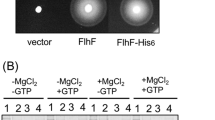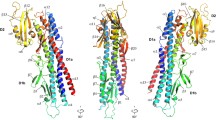Abstract
The single subpolar flagellum of Rhodobacter sphaeroides shows an enlarged hook-filament junction. One of the two proteins that compose this section of the filament is HAP1 Rs (FlgK Rs ) it contains a central non-conserved region of 860 amino acids that makes this protein about three times larger than its homologue in Salmonella enterica serovar Typhimurium. We investigated the role of this central portion of the unusually large HAP1 protein of R. sphaeroides by monitoring the effects of serial deletions in flgK Rs , the gene encoding HAP1 Rs , on swimming and swarming. Two deletion mutants did not assemble functional flagella, two were paralyzed and five exhibited reduced free-swimming speeds. Some mutants produced unusual swarming patterns on soft agar without or with Ficoll 400. A segment of approximately 200-aa of the central region of HAP1 Rs that aligns with the variable region of the flagellin sequence from other γ- and β-proteobacteria was also found. Therefore, it is possible that the origin of this large central domain of HAP1 Rs could be associated with an event of horizontal transfer and subsequent duplications and/or insertions.




Similar content being viewed by others
References
Aizawa SI, Vonderviszt F, Ishima R, Akasaka K (1990) Termini of Salmonella flagellin are disordered and become organized upon polymerization into flagellar filament. J Mol Biol 211:673–677
Aldridge P, Hughes KT (2002) Regulation of flagellar assembly. Curr Opin Microbiol 5:160–165
Ausubel FM, Brent R, Kingston RE, Moore DD, Seidman JG, Smith JA, Struhl K (1987) Current protocols in molecular biology. Wiley, New York
Chen BG, Turner L, Berg HC (2007) The wetting agent required for swarming in Salmonella enterica serovar typhimurium is not a surfactant. J Bacteriol 189:8750–8753
Davis J, Donohue TJ, Kaplan S (1988) Construction, characterization, and complementation of a Puf-mutant of Rhodobacter sphaeroides. J Bacteriol 170:320–329
Fahrner KA, Block SM, Krishnaswamy S, Parkinson JS, Berg HC (1994) A mutant hook-associated protein (HAP3) facilitates torsionally induced transformations of the flagellar filament of Escherichia coli. J Mol Biol 238:173–186
Gal P, Vegh B, Zavodszky P, Vonderviszt F (2006) Export signals. Nat Biotechnol 24:900–901 author reply 901–902
González-Pedrajo B, De la Mora J, Ballado T, Camarena L, Dreyfus G (2002) Characterization of the flgG operon of Rhodobacter sphaeroides WS8 and its role in flagellum biosynthesis. Biochim Biophys Acta 1579:55–63
Harlow E, Lane D (1988) Antibodies: a laboratory manual. Cold Spring Harbor, New York
Ho SN, Hunt HD, Horton RM, Pullen JK, Pease LR (1989) Site-directed mutagenesis by overlap extension using the polymerase chain reaction. Gene 77:51–59
Homma M, DeRosier DJ, Macnab RM (1990a) Flagellar hook and hook-associated proteins of Salmonella typhimurium and their relationship to other axial components of the flagellum. J Mol Biol 213:819–832
Homma M, Kutsukake K, Hasebe M, Iino T, Macnab RM (1990b) FlgB, FlgC, FlgF and FlgG A family of structurally related proteins in the flagellar basal body of Salmonella typhimurium. J Mol Biol 211:465–477
Horton RM, Hunt HD, Ho SN, Pullen JK, Pease LR (1989) Engineering hybrid genes without the use of restriction enzymes: gene splicing by overlap extension. Gene 77:61–68
Horton RM, Cai ZL, Ho SN, Pease LR (1990) Gene splicing by overlap extension: tailor-made genes using the polymerase chain reaction. Biotechniques 8:528–535
Ikeda T, Homma M, Iino T, Asakura S, Kamiya R (1987) Localization and stoichiometry of hook-associated proteins within Salmonella typhimurium flagella. J Bacteriol 169:1168–1173
Keen NT, Tamaki S, Kobayashi D, Trollinger D (1988) Improved broad-host-range plasmids for DNA cloning in gram-negative bacteria. Gene 70:191–197
Kobayashi K, Saitoh T, Shah DS, Ohnishi K, Goodfellow IG, Sockett RE, Aizawa SI (2003) Purification and characterization of the flagellar basal body of Rhodobacter sphaeroides. J Bacteriol 185:5295–5300
Kuwajima G (1988) Construction of a minimum-size functional flagellin of Escherichia coli. J Bacteriol 170:3305–3309
Laemmli UK (1970) Cleavage of structural proteins during the assembly of the head of bacteriophage T4. Nature 227:680–685
Lowry OH, Rosebrough NJ, Farr AL, Randall RJ (1951) Protein measurement with the Folin phenol reagent. J Biol Chem 193:265–275
Macnab RM (2003) How bacteria assemble flagella. Annu Rev Microbiol 57:77–100
Malapaka RR, Adebayo LO, Tripp BC (2007) A deletion variant study of the functional role of the Salmonella flagellin hypervariable domain region in motility. J Mol Biol 365:1102–1116
Metcalf WW, Wanner BL (1993) Construction of new beta-glucuronidase cassettes for making transcriptional fusions and their use with new methods for allele replacement. Gene 129(1):17–25
Mimori Y, Yamashita I, Murata K, Fujiyoshi Y, Yonekura K, Toyoshima C, Namba K (1995) The structure of the R-type straight flagellar filament of Salmonella at 9 A resolution by electron cryomicroscopy. J Mol Biol 249:69–87
Mimori-Kiyosue Y, Vonderviszt F, Namba K (1997) Locations of terminal segments of flagellin in the filament structure and their roles in polymerization and polymorphism. J Mol Biol 270:222–237
Mimori-Kiyosue Y, Yamashita I, Fujiyoshi Y, Yamaguchi S, Namba K (1998) Role of the outermost subdomain of Salmonella flagellin in the filament structure revealed by electron cryomicroscopy. J Mol Biol 284:521–530
Morgan DG, Owen C, Melanson LA, DeRosier DJ (1995) Structure of bacterial flagellar filaments at 11 A resolution: packing of the alpha-helices. J Mol Biol 249:88–110
Namba K, Vonderviszt F (1997) Molecular architecture of bacterial flagellum. Q Rev Biophys 30:1–65
Poggio S, Osorio A, Dreyfus G, Camarena L (2005) The flagellar hierarchy of Rhodobacter sphaeroides is controlled by the concerted action of two enhancer-binding proteins. Mol Microbiol 58:969–983
Poggio S, Abreu-Goodger C, Fabela S, Osorio A, Dreyfus G, Vinuesa P, Camarena L (2007) A complete set of flagellar genes acquired by horizontal transfer coexists with the endogenous flagellar system in Rhodobacter sphaeroides. J Bacteriol 189:3208–3216
Porter SL, Wadhams GH, Armitage JP (2008) Rhodobacter sphaeroides: complexity in chemotactic signalling. Trends Microbiol 16:251–260
Quandt J, Hynes MF (1993) Versatile suicide vectors which allow direct selection for gene replacement in gram-negative bacteria. Gene 127:15–21
Samatey FA, Imada K, Vonderviszt F, Shirakihara Y, Namba K (2000) Crystallization of the F41 fragment of flagellin and data collection from extremely thin crystals. J Struct Biol 132:106–111
Samatey FA, Imada K, Nagashima S, Vonderviszt F, Kumasaka T, Yamamoto M, Namba K (2001) Structure of the bacterial flagellar protofilament and implications for a switch for supercoiling. Nature 410:331–337
Samatey FA, Matsunami H, Imada K, Nagashima S, Shaikh TR, Thomas DR, Chen JZ, Derosier DJ, Kitao A, Namba K (2004) Structure of the bacterial flagellar hook and implication for the molecular universal joint mechanism. Nature 431:1062–1068
Scharf B, Schuster-Wolff-Buhring H, Rachel R, Schmitt R (2001) Mutational analysis of the Rhizobium lupini H13-3 and Sinorhizobium meliloti flagellin genes: importance of flagellin A for flagellar filament structure and transcriptional regulation. J Bacteriol 183:5334–5342
Schultz J, Milpetz F, Bork P, Ponting CP (1998) SMART, a simple modular architecture research tool: identification of signaling domains. Proc Natl Acad Sci USA 95:5857–5864
Simon R, Priefer U, Pühler A (1983) A broad host range mobilization system for in vivo genetic engineering: transposon mutagenesis in gram-negative bacteria. Bio/Technology 1:37–45
Sistrom WR (1962) The kinetics of the synthesis of photopigments in Rhodopseudomonas sphaeroides. J Gen Microbiol 28:607–616
Sockett RE, Foster JCA, Armitage JP (1990) Molecular biology of the Rhodobacter sphaeroides flagellum. FEMS Symp 53:473–479
Stagg L, Zhang SQ, Cheung MS, Wittung-Stafshede P (2007) Molecular crowding enhances native structure and stability of alpha/beta protein flavodoxin. Proc Natl Acad Sci USA 104:18976–18981
Uedaira H, Morii H, Ishimura M, Taniguchi H, Namba K, Vonderviszt F (1999) Domain organization of flagellar hook protein from Salmonella typhimurium. FEBS Lett 445:126–130
Vonderviszt F, Zavodszky P, Ishimura M, Uedaira H, Namba K (1995) Structural organization and assembly of flagellar hook protein from Salmonella typhimurium. J Mol Biol 251:520–532
Wang Q, Suzuki A, Mariconda S, Porwollik S, Harshey RM (2005) Sensing wetness: a new role for the bacterial flagellum. EMBO J 24:2034–2042
Warrens AN, Jones MD, Lechler RI (1997) Splicing by overlap extension by PCR using asymmetric amplification: an improved technique for the generation of hybrid proteins of immunological interest. Gene 186:29–35
Wessel D, Flugge UI (1984) A method for the quantitative recovery of protein in dilute solution in the presence of detergents and lipids. Anal Biochem 138:141–143
West MA, Dreyfus G (1997) Isolation and ultrastructural study of the flagellar basal body complex from Rhodobacter sphaeroides WS8 (wild type) and a polyhook mutant PG. Biochem Biophys Res Commun 238:733–737
Yamashita I, Vonderviszt F, Mimori Y, Suzuki H, Oosawa K, Namba K (1995) Radial mass analysis of the flagellar filament of Salmonella: implications for the subunit folding. J Mol Biol 253:547–558
Yonekura K, Maki S, Morgan DG, DeRosier DJ, Vonderviszt F, Imada K, Namba K (2000) The bacterial flagellar cap as the rotary promoter of flagellin self-assembly. Science 290:2148–2152
Yonekura K, Maki-Yonekura S, Namba K (2002) Growth mechanism of the bacterial flagellar filament. Res Microbiol 153:191–197
Acknowledgments
We thank Bertha González-Pedrajo, Diego González-Halphen and Dimitris Georgellis for helpful discussions. Aurora Osorio and Javier de la Mora for technical assistance and the IFC Molecular Biology Unit for DNA sequencing and the microscopy unit for the electron micrographs. D.C. and this study, were supported by grants from Consejo Nacional de Cienciay Tecnología (176586, 47172/A-1) and DGAPA/UNAM (IN213408).
Author information
Authors and Affiliations
Corresponding author
Rights and permissions
About this article
Cite this article
Castillo, D.J., Ballado, T., Camarena, L. et al. Functional analysis of a large non-conserved region of FlgK (HAP1) from Rhodobacter sphaeroides . Antonie van Leeuwenhoek 95, 77–90 (2009). https://doi.org/10.1007/s10482-008-9290-7
Received:
Accepted:
Published:
Issue Date:
DOI: https://doi.org/10.1007/s10482-008-9290-7




